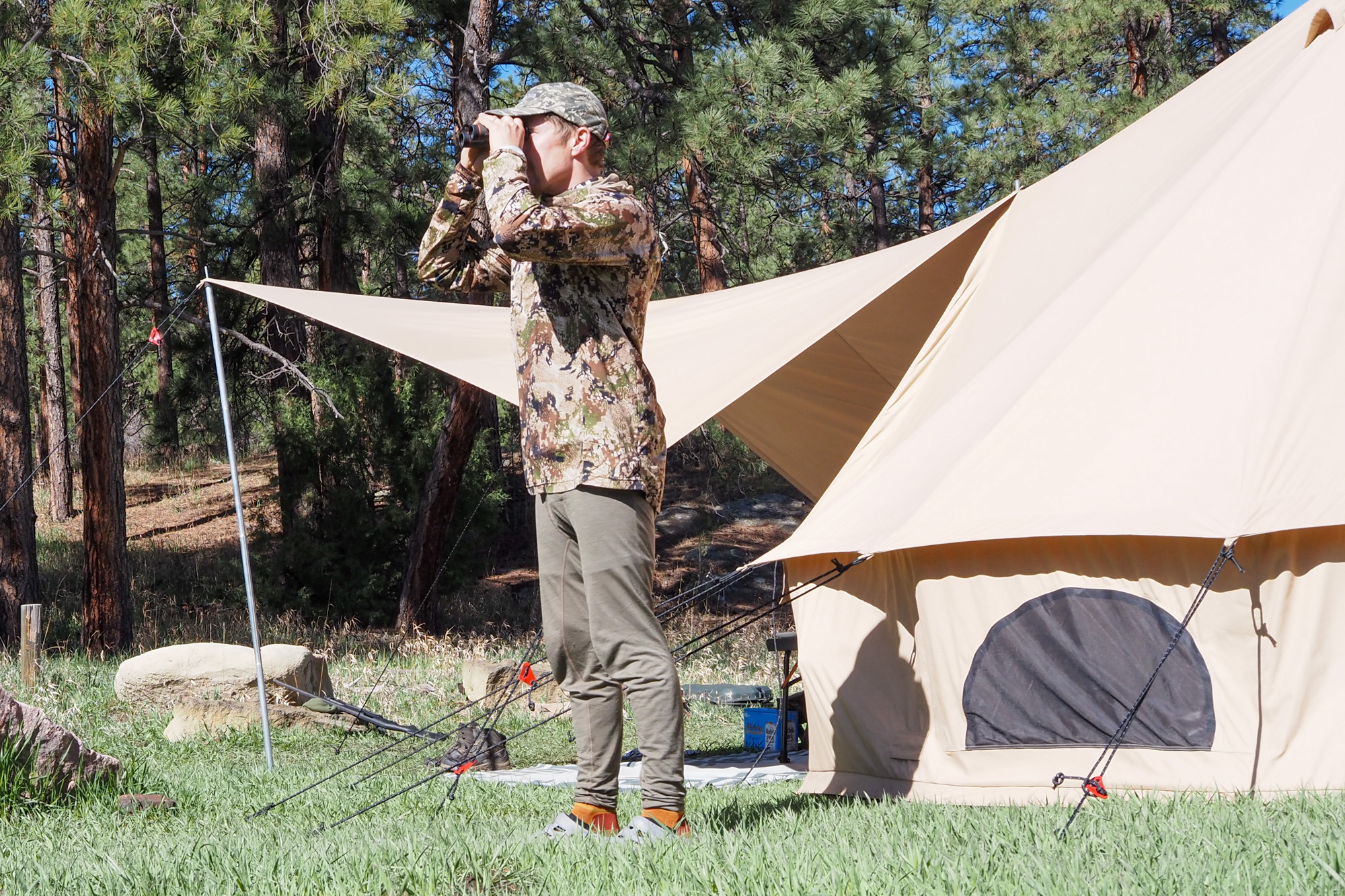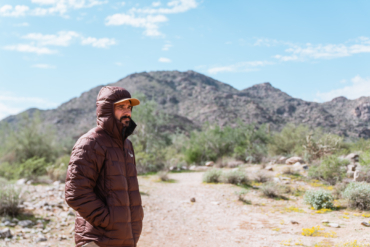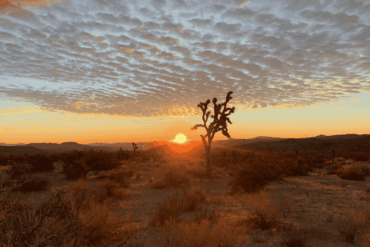Getting close to animals with a bow and arrow is no easy feat. Spot-and-stalk bowhunting is an art form that few will ever master.
My memories are still quite vivid. When I was a young boy, Dad would take me on deer hunts with him. He’d selflessly try and get me close to deer, even if it meant he didn’t fill his tag.
Whether we were crawling on our hands and knees or simply just walking slow, there were sometimes we’d get within spitting distance of deer. It seemed like a magic trick at the time. The more we did this with trial and error, though, the more I realized there was a process to it all — a process that I’d apply to my spot-and-stalk bowhunting endeavors later in life.
Spot-and-Stalk?
Hands down, the most popular form of bowhunting is sitting in a tree and waiting for a deer to walk by. This is exhilarating in its own right, and I encourage you to try it out if you haven’t. It’s a form of ambush hunting.
Instead of waiting for an animal to come to you, spot-and-stalk bowhunting is when you go to the animal. Bowhunters spot game animals from far off with optics and try to figure out a way to get close for an archery shot. This type of hunting is often better applied to a more open country where there is more visibility, though useful in dense areas as well for an experienced hunter.
Successful spot-and-stalk bowhunting is a series of moving parts that all work together in order to solve the puzzle that is getting within bow range of an animal. It’s chaotic, blissful, and the ultimate test in bowhunting skills.
Glassing Is the Best Way to ‘Spot’

This method of hunting is called “spot-and-stalk” bowhunting. So, the first step in the equation is to spot. The best way to go about doing this is from afar with high-powered optics, a tactic that is called glassing.
Glassing allows a hunter to stay back and watch animals in a very nonintrusive way. There is no better way to plan a stalk than observing where and what the animal does naturally before making your way over to it.
I prefer to have an elevated vantage point for glassing. This gives a commanding view of the country beneath me. That said, being down low and looking up can work as well. The disadvantage with being lower is that you’re often contending with having to look through more vegetation, much more so than if you were looking from above.

The best way I have found to glass is by grid searching. I’ll break the country up into sections and scan left to right, top to bottom. This ensures that I’m seeing all of the country in front of me in a calculated manner.
Having your optics mounted on a tripod is essential for this type of glassing. It will take your critter-spotting abilities to the next level and allow you to see movement much better. Plus, you can lock your optics in place once you do find an animal.
A 10×42 binocular is a great all-around magnification for glassing. I like pairing that with a 65mm spotting scope to get a closer look as well.
After an Animal Is Spotted
Once an animal is spotted, don’t just pick up and start running over there. First, you need to analyze what they are doing in order to make an educated decision on your actions in the future.
Think of this like a chess match. You’re trying to see what they are doing in the present and predict what they’ll do in the future. While there are many variables at play, there are a few situations that are better than others.
Bedded
A bedded animal is one that usually isn’t going anywhere anytime soon. Knowing exactly where the animal is, rather than trying to predict where they are going to be, is a huge advantage for a spot-and-stalk bowhunter. This situation allows for the most calculated of approaches and really lets you plan a well-thought-out stalk.
Feeding

An animal that is feeding is one that is preoccupied. And while they are indeed on their feet, their movements are usually focused in a small area. With their attention on food, making noise eating, and staying in a fairly small area, this is a great situation for a spot-and-stalk bowhunter to capitalize on.
Traveling
A traveling animal is one that can be met in the middle. Cutting an animal off as they are moving through the country will allow you to be set up and have the animal come to you or pass by you.
This is another great play for a bowhunter, but there is one caveat: the distance between you and the animal and the time it takes to get to an ambush point. The greater either of those is, the less chance this will work out.
How to Close the Distance

Now that the animal has been spotted and the planning/strategizing of a stalk has happened, it’s time to beat feet and try to make all of this come together.
Things to Pay Attention to on Your Way
There are a few crucial things you’ll want to keep in mind during your approach.
Wind
Far and away, the primary thing to pay attention to on your way over to a critter is wind. Wind will cripple the most perfect of stalking routes in a hurry.
The tricky part can be that wind is not always going to be the same from where you’re glassing to where the animal is. I try to pay attention to which way the grass is blowing on their side. That’s a huge help.
Along with that, always, and I mean always, carry some type of windicator bottle or have access to naturally occurring wind indication material (dry dirt, light vegetation). Use it often, as the wind can change in a hurry from spot to spot during your approach.
Don’t be afraid to back out if the wind isn’t right, either. It’s a far better choice of action than risking spooking the animal out of the area completely with your human funk.
In general, the wind tends to blow uphill during the heat of the day and downhill first thing in the morning and in the evening.
Footfall

The ground beneath our feet in the hills is rarely quiet. It’s quite the opposite, usually. This means that we have to be very cognizant of our footfall.
Gently placing your foot on the ground will be far less noisy than how you’d normally walk outside of stalking animals. Remember, we’re trying to sneak here.
Don’t let your foot just hit the ground step after step. Gradually place it down, slowly increasing the amount of weight you put on it before committing to the next step.
Soft-sole boots, sneakers, or even just socks are going to be best for this. These are naturally quieter as well.
Shadows
Shadows are another thing to pay attention to. Trying to stay in the shadows while making your approach will help you not stick out as much. We pop in the sunlight.
Also, you need to pay attention to your own shadow. This is especially true when approaching an animal from above and behind. Your shadow is going to be the first thing that creeps over the edge of a bluff if the sun is behind you. If an animal catches that movement of your shadow, the gig is up.
The Animal’s Eyes
A general rule of thumb is if you can’t see the animal’s eyes, then they can’t see you. Use the topography and natural vegetation in the area to help break their line of sight to you.
Even if an animal is bedded and facing your approach, by placing a tree in between you and their eyes, you can avoid detection. I’ve personally done this many times and gotten within bow range successfully.
In the ‘Red Zone’

Intensity levels increase quite a bit once getting into bow range. The closer you get, the more the details matter for both avoiding detection and making a well-placed shot. Pay attention to how the animal is acting. You’ll be able to tell if they are nervous or don’t have a clue that you’re there.
If they do spot you, don’t move a muscle and avoid showing them your eyes. A hat bill works great for this. A lot of times, they’ll stare at you for a bit and then calm right back down, continuing on with what they were doing.
Be sure to range multiple things around you, not just the animal. If they, for some reason, move from their position when or after you draw your bow, it’s nice to know these other ranges for reference.
And finally, take your time. We often have much more time than we think to execute a shot. Rushing will get you in trouble. Focus will put the arrow where it needs to go.
This Is a Process

One definition of the word process is “a series of actions or steps taken in order to achieve a particular end.” This is the perfect description of what successful spot-and-stalk bowhunting is all about.
Familiarizing yourself with this process is not something that happens overnight. It takes work and negotiating through many lessons along the way.
I promise you that with time and dedication, this spot-and-stalk bowhunting business will come together for you. When it does, get ready for a new level of addiction.









